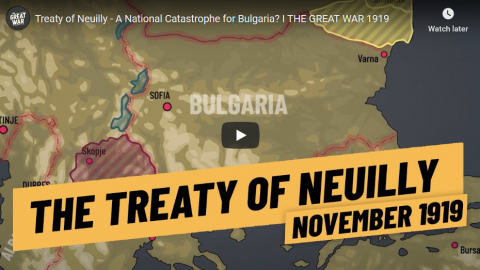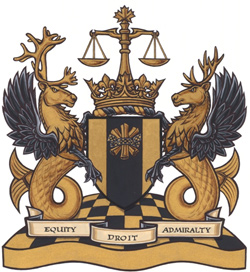Eoin MacFreeman
Published 19 Sep 2014STV and History channel documentary to coincide with the 70th anniversary of the sinking of HMS Royal Oak at Scapa Flow in Scotland. With harrowing eye witness accounts from survivors. Narrated by oor Alex Norton. We will remember them.
On 14 October 1939, Royal Oak was anchored at Scapa Flow in the Orkney Islands, Scotland, when she was torpedoed by the German submarine U-47. Of Royal Oak‘s complement of 1,234 men and boys, 833 were killed that night or died later of their wounds. The loss of the old ship – the first of the five Royal Navy battleships and battlecruisers sunk in the Second World War – did little to affect the numerical superiority enjoyed by the British navy and its allies, but the sinking had considerable effect on wartime morale. The raid made an immediate celebrity and war hero out of the U-boat commander, Günther Prien, who became the first German submarine officer to be awarded the Knight’s Cross of the Iron Cross. Before the sinking of Royal Oak, the Royal Navy had considered the naval base at Scapa Flow impregnable to submarine attack, and U-47‘s raid demonstrated that the German navy was capable of bringing the war to British home waters. The shock resulted in rapid changes to dockland security and the construction of the Churchill Barriers around Scapa Flow.
November 20, 2019
The Sinking of the Royal Oak
“Europe is committing suicide. Or at least its leaders have decided to commit suicide.”
Barbara Kay on the works of Douglas Murray, a “clubbable conservative” (I’m so far out of the loop, I’m not sure if this reference is British (he’s welcome in our exclusive club) or Canadian (like a baby harp seal) … although that may be a binary answer depending if you’re on the left or right of the traditional political spectrum):
London-based public intellectual Douglas Murray is in Montreal this week to promote his new book. I was afforded the luxury of a rambling conversation over coffee with him about The Madness of Crowds: Gender, Race and Identity.
A “clubbable conservative,” as one reviewer accurately describes him, Murray hit his intellectual stride early, publishing his first book at 18, which attracted the attention and mentorship of polemical giants Christopher Hitchens and Roger Scruton. Quite different in personality from Jordan Peterson (less intensity, more suavity), he’s equally erudite and similarly crowd-pleasing (they’ve done joint appearances in the U.K., attracting massive audiences).
Murray shot to international celebrity with his powerful, if depressing 2017 book, The Strange Death of Europe, which opens with the words, “Europe is committing suicide. Or at least its leaders have decided to commit suicide.” Joining frontline reports from unpleasant way stations in the 2015 migrant crisis to insightful analysis of the West’s present malaise, Murray painted a gloomy picture of continental passivity in the face of momentous cultural change.
In The Madness of Crowds, also inspired by the West’s loss of a “grand narrative,” Murray applies his formidable exegetical skills to the proliferation of identity politics “tripwires” that corrode civic life and wreak havoc with individual lives.
Murray writes: “The interpretation of the world through the lens of ‘social justice,’ ‘identity group politics’ and ‘intersectionalism’ is probably the most audacious and comprehensive effort since the Cold War at creating a new ideology.” Christianity has been spurned, but the religious impulse is inherent and abhors a vacuum. The “religion” of social justice, Murray observes, poured itself into the handy campus vessel of Marxism with remarkable speed.
One of the hallmarks of Marxism – not a bug, but a feature – is its ruthlessness. I was particularly struck by Murray’s quite poignant chapter, “On Forgiveness.” Normal religions offer redemption to sinners. But there is no forgiveness or statute of limitations for thoughtcrimes in the religion of social justice. A mural of Rudyard Kipling’s “If” – voted Britain’s favourite poem – was painted over at the University of Manchester in retroactive punishment for Kipling’s now politically incorrect views on empire. The past, Murray says, is “hostage — like everything else — to any archeologist with a vendetta.”
Treaty of Neuilly – A National Catastrophe for Bulgaria? I THE GREAT WAR 1919
The Great War
Published 19 Nov 2019SPONSORED: Install Raid for Free ✅ IOS: http://bit.ly/334B7Yl ✅ ANDROID: http://bit.ly/341srDB
Start with💰50K silver and get a Free Epic Champion 💥 on day 7 of “New Player Rewards” program**Ads like this support the production of our channel and keep it free to watch for everyone
» SUPPORT THE CHANNEL
Patreon: https://www.patreon.com/thegreatwar
Merchandise: https://shop.spreadshirt.de/thegreatwar/» SOURCES
Borodziej, Wlodzimierz and Maciej Gorny. Der Vergessene Weltkrieg. Europas Osten 1912-1923. Band II – Nationen 1917-1923 (wbg Theiss, 2018).
Ganev, P. “The relations between Bulgaria and the FYR of Macedonia in the context of EU integration,” Master Thesis, 2014.
Gerwarth, Robert. The Vanquished. Why the First World War Failed to End, 1917-1923 (Penguin, 2017).
Khristov, Khristo. “Bulgaria, the Balkans, and the Peace of 1919,” in Pastor, Peter, ed. Revolutions and Interventions in Hungary and its Neighbor States, 1918-1919 (New York: Columbia University Press, 1988).
Lampe, John. “Stamboliiski’s Bulgaria and Revolutionary Change, 1918-1923,” in Pastor, Peter, ed. Revolutions and Interventions in Hungary and its Neighbor States, 1918-1919 (New York: Columbia University Press, 1988).
Leonhard, Jörn. Der überforderte Frieden. Versailles und die Welt 1918-1923 (CH Beck, 2018).
Macmillan, Margaret. The Peacemakers: Six Months that Changed the World (London: John Murray, 2001).
Mihaylovski, Stoyan. “On the Treaty of Neuilly,” in Напред (Forward). Originally published November 4th, 1919. Republished on November 27th, 2018. Retrieved via Dir.bg.
Minkov, Stefan Marinov: “Neuilly-sur-Seine, Treaty of”, in: 1914-1918-online. International Encyclopedia of the First World War, ed. by Ute Daniel, Peter Gatrell, Oliver Janz, Heather Jones, Jennifer Keene, Alan Kramer, and Bill Nasson, issued by Freie Universität Berlin, Berlin 2017-02-20.
Pantev, Andrei. “The Border Line Between Sympathy and Support: the United States and the Bulgarian Territorial Question at the Paris Peace Conference in 1919,” in Southeastern Europe, 8, pts 1-2 (1981): 171-197.
Ristović, Milan: “Occupation during and after the War (South East Europe)”, in: 1914-1918-online. International Encyclopedia of the First World War, ed. by Ute Daniel, Peter Gatrell, Oliver Janz, Heather Jones, Jennifer Keene, Alan Kramer, and Bill Nasson, issued by Freie Universität Berlin, Berlin 2014-10-08.
Toshev, Stefan. Pobedeni bez da badem biti (Beaten without being defeated), 1924.
Vazov, Vladimir. Zhivotopisni belejki (Lifetime notes). Re-published by Bulgarian History “BI 93 OOD”, 2018.
Yotov, Petko et al. Bulgaria in the First World War (1915-1918), a short encyclopedia (2014).
Documentary film: Българският политик Теодор Теодоров – държавник от първа величина, ISTORIYA.BG, 03.12.2018
Съюз на македонските емигрантски организации в България – “Memoir presented to the governments of the United States of America, of Great Britain and Ireland, of France, of Italy and of Japan”, София, 1919 година (http://strumski.com/biblioteka/?id=1830)»CREDITS
Presented by: Jesse Alexander
Written by: Jesse Alexander
Director: Toni Steller & Florian Wittig
Director of Photography: Toni Steller
Sound: Toni Steller
Editing: Toni Steller
Mixing, Mastering & Sound Design: http://above-zero.com
Maps: Daniel Kogosov (https://www.patreon.com/Zalezsky)
Research by: Jesse Alexander
Fact checking: Florian WittigChannel Design: Alexander Clark
Original Logo: David van StepholdA Mediakraft Networks Original Channel
Contains licensed material by getty images
All rights reserved – Real Time History GmbH 2019
Activist court watch – Federal Court of Canada judge creates new website blocking rules
Michael Geist on the precedent-setting decision from the Federal Court of Canada:
A Federal Court of Canada judge issued a major website blocking decision late Friday, granting a request from Bell, Rogers, and Groupe TVA to block access to a series of GoldTV streaming websites. The order covers most of the Canada’s large ISPs: Bell, Eastlink, Cogeco, Distributel, Fido, Rogers, Sasktel, TekSavvy, Telus, and Videotron. The case is an important one, representing the first extensive website blocking order in Canada. It is also deeply flawed from both a policy and legal perspective, substituting the views of one judge over Parliament’s judgment and relying on a foreign copyright case that was rendered under markedly different legal rules than those found in Canada.
Perhaps most troubling is that the judge has created a substantive new policy framework for site blocking, an issue that given the many complex policy issues (including copyright enforcement, freedom of expression, net neutrality, and telecom competition) is best left to Parliament. Indeed, the activist judicial approach explicitly engages in an analysis that considers many of the policy issues but arrives at its own conclusion about how best to balance competing interests. These are issues that are best left to elected officials. The Standing Committee on Industry, Science and Economic Development, which completed the comprehensive copyright review earlier this year, heard extensive submissions from groups calling for reforms to the law to include site blocking. It instead recommended:
Following the review of the Telecommunications Act, that the Government of Canada consider evaluating tools to provide injunctive relief in a court of law for deliberate online copyright infringement and that paramount importance be given to net neutrality in dealing with impacts on the form and function of Internet in the application of copyright law.
In other words, the committee recommended holding off on a site blocking rule until further study is conducted. Moreover, it concluded that “paramount importance be given to net neutrality.” The judge in GoldTV acknowledged that there were net neutrality concerns (rejecting claims that “net neutrality is of no application where a site blocking order is sought.”), but concluded that the net neutrality issues did not tip the balance against granting the injunction. Not only is that inconsistent with the copyright review emphasis of paramountcy for net neutrality, but it represents the judge making a policy choice best left to elected officials.
The CRTC, which rejected a proposal for an administrative site blocking system in the FairPlay case, also thought the issue was best left to the government. Its ruling specifically cited the copyright review and the review of the Broadcasting and Telecommunications Act as avenues to address the issue. In other words, the appropriate venue to consider site blocking was government, not an administrative agency.
Sterling Meets Owen: The Australian F1 Submachine Gun
Forgotten Weapons
Published on 20 Sep 2019http://www.patreon.com/ForgottenWeapons
Cool Forgotten Weapons merch! http://shop.bbtv.com/collections/forg…
The Australian Owen submachine gun was once of the best overall SMG designs of the Second World War, and when Australia decided to replace them in the 1960s, the new F1 design had big shoes to fill. The basic configuration of the top-mounted magazine remained, but coupled with elements of the Sterling SMG. The F1 used a simple sheet metal tube receiver with elements welded on, and a typical open bolt, blowback operating system. The unique rear system of separating the recoil spring from the main receiver body in the Owen was not included, instead using a basic open tube and large diameter mainspring. The sights are curiously still mounted to the right side of the gun, with a thin folding rear sight and a front sight affixed to the magazine well. These simplifications did have the effect of lightening the F1 compared to the Owen, which is a nice improvement. The F1 was manufactured from 1962 until 1973, with a total of about 25,000 made. It served in Vietnam and through the 1990s, when replaced by a variant of the F88 Austeyr. All reports are that it was a perfectly adequate submachine gun, but it did not earn the affection of troops like the Owen had.
Contact:
Forgotten Weapons
6281 N. Oracle #36270
Tucson, AZ 85704
QotD: Theorizing an American police state
With apologies to Margaret Atwood and a thousand other dystopian novelists, we do not have to theorize about what an American police state would look like, because we know what it looks like: the airport, that familiar totalitarian environment where Americans are disarmed, stripped of their privacy, divested of their freedom of speech, herded around like livestock, and bullied by bovine agents of “security” in a theatrical process that has an 85 percent failure rate because it isn’t designed as a security-screening protocol at all but as a jobs program for otherwise unemployable morons.
Kevin D. Williamson, “O’Rourke’s America”, National Review, 2019-10-16.








